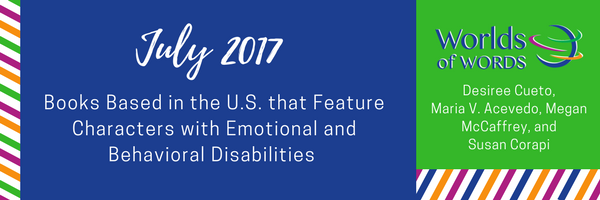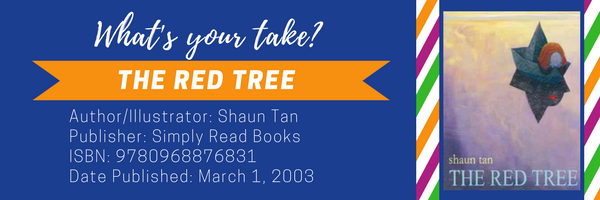
This month we are continuing our conversation about the portrayal of disabilities in picturebooks (see August 2016 and February 2017). Our focus in the following discussions is on emotional and behavioral disabilities, so we will look at characters who wrestle with childhood depression, anxiety, and outbursts. The books we discussed last August and February won the Schneider Family Award for the Portrayal of the Disability Experience. The titles discussed this month, beginning with The Red Tree, have not won that award, but they could have!

MEGAN: The Red Tree, written and illustrated by Shaun Tan, shows the dark and melancholy disposition of the red-haired girl in the story. When the young girl awakes, the story reads, “sometimes the day begins/with nothing to look forward to/and things go from bad to worse.” Throughout the story, which seems to take place over the course of a day, the girl wanders around big, and often busy and complex space in a downtrodden mood. At the end of the day, she returns to her room and the small red leaf framed above her bed has sprouted so that on the floor of her room a bright, flame-colored tree appears, providing a glimmer of hope.
The images are fantastic and full of metaphors. The young girl surfaces in a tiny boat, trapped in a bottle with an old time metal scuba helmet, strolls under a giant floating fish, and walks on a bed of skulls. Tan provides intricate details in each picture that can be viewed over and over, each time finding something new.
This story attempts to show that, just as much as sad feelings are unavoidable in each of our lives, the negative should be mitigated by surrounding hope. Throughout the story, despite the overwhelming gloom, there is always a tiny red maple leaf that acts symbolically as hope. Hope is not always in the forefront as it is in the last picture of the story, but it is always present in every frame. When the girl returns home, she sees a delicate red sprout growing out of her floor. The story reads, “but suddenly there it is/right in front of you/bright and vivid/quietly waiting.” On the final page, she lifts her head and smiles. The girl’s smile at the end of the story is the only time her mouth is seen throughout the story. The red maple leaf serves as a reminder that hope, and quite literally life, with the vibrant red tree’s manifestation, can occur despite miserable conditions.
This topic is seldom broached in children’s literature and definitely not with such treatment. The text never explicitly states that the girl is depressed, though it is obvious throughout the story. The book never explicitly mentions hope, but presents it in each frame. This book can be useful to approach many mental health topics and/or a single bad day with many ages levels. The story is subtle enough and yet the message is clear and poignant. I may be hesitant to use this story with ages below first grade unless there was a specific need. While I love the book, it is gloomy for the most part.
DESIREE: I am hesitant to say that I would withhold a book from younger readers. You have done a wonderful job of describing the thought-provoking images and metaphors that grace the pages of this stunning book. This book might resonate differently with a younger audience. Younger readers might connect to the sadness depicted in the text and illustrations even if they are not able to verbalize their experience. Like the protagonist, the world that most children encounter today is bombarded with constant news and information, much of which is overwhelming. It is important that they see this reflected in a book. Perhaps this girl’s depression and the ways in which she manages it will provide a sense of hope (as you have keenly pointed out) in a seemingly hopeless world.
If you were to establish a cutoff age, what would that be? If you were to introduce this book to younger readers, how might you contextualize it?
MEGAN: I would not withhold a book from students’ independent use, though I may not use it as an instructor. I am on the fence with the heaviness of the story. I would not have an issue discussing being sad or individuals who may have longer sad periods with younger students. That being said, I am not absolutely opposed to its use. The illustrations themselves without any text could be used for discussion. The illustrations are also extraordinary, as are all of the Tan’s illustrations. Lastly, this book has many characteristics of a good beginner reader–from a sound plot with a beginning, middle, and end to minimal text on a page. I struggle with the content and if this gloomy story is a best practice for kindergarteners and first graders. This book is great, content-wise for junior high and up. In fact, “content-wise” for older students, this subject is handled beautifully. As I stated earlier, there is a tiny red leaf in each frame that represents hope; hope is always present. Mostly for that reason, this book is perfect for older students. Yes, it has a happy ending, similar to many U.S. books, but it also remains open ended. What happens tomorrow when the young red haired girl wakes up? Obviously this is a day in the life, and depression or sadness may well continue each day she awakes.
Desiree, do you interpret the girl’s sadness as a result of overwhelming feelings? I also am not sure how she copes?
DESIREE: Megan, prior to responding to your question, I read a startling statistic. According to the Federal Center for Mental Health Services, depression affects as many as one in every 33 children and one in eight adolescents. While I agree that the words and illustrations in this book are better suited for an older audience, I would consider introducing it at the intermediate level (grades 3 and up). The sense of foreboding that the book evokes is all too familiar to this age group. Like other great works of fiction, this book provides a space to grapple with those feelings. For children who have depression, this book serves as a mirror. In terms of your question about how this character copes with the depression, it is not clear. The sense of hope comes primarily from the image of the red flower. Perhaps the message is that life is always changing and new beginnings are possible. As you point out, only in America are neatly tied, happy endings expected in picturebooks.
Title: The Red Tree
Author/Illustrator: Shaun Tan
Publisher: Simply Read Books
ISBN: 9780968876831
Date Published: March 1, 2003
This is the first installment of July’s My Take/Your Take. To follow the whole conversation, check the WOW Blog every Wednesday.
- Themes: Desiree Cueto, Maria V. Acevedo, Megan McCaffrey, Red Tree, shaun tan, Susan Corapi
- Descriptors: Books & Resources, My Take/Your Take
